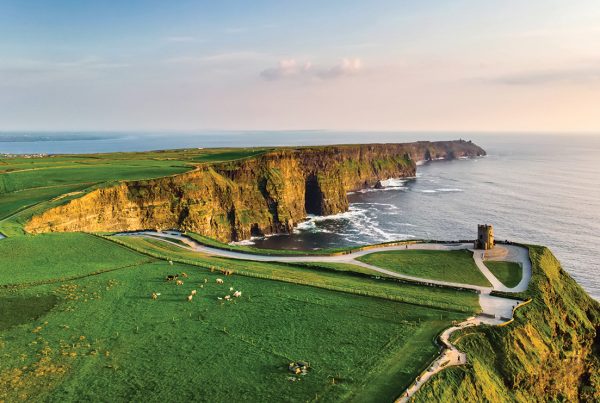In the November-December issue, we interviewed Robert De Palma, a paleontologist and FAU adjunct professor, who every summer makes a pilgrimage to a Tanis, a fossil site in Hell Creek, North Dakota, that is re-writing our knowledge of the extinction of the dinosaurs. De Palma’s literally groundbreaking discoveries were unveiled to the world earlier this year in a New Yorker profile, and were published soon thereafter in peer-reviewed academic journals.
De Palma’s research does no less than pinpoint the precise moment, 66 million years ago, when an asteroid slammed into what is now that Yucatan Peninsula and wiped out an entire species. For the full story, pick up the current issue of Boca magazine. For more with De Palma, read on.
Did you know in your first year visiting Hell Creek that you had come upon a game changer? What was the a-ha moment?
There were a couple of them. The initial game-changer was when we were informed about the site. It was a tipoff from a commercial group. There was a group of basically hobbyists who went out there and would bring the public out for a week at a time. They would pay to dig, and then whatever they dug up, the leaders of those trips would then sell, for profit, on the open market. They encountered a site with lots of fish. They thought it was a lake or something. They told me about it. And I thought, that’s unique, because only five fish had come out of the Hell Creek formation at that point. So my scientific basis tells me that in order to have that many fish at one place, you had to have a very unique depositional circumstance, which equals very good preservation of uncommon things. To me, that’s gold, I like it, and I want to go study it.
They did not want to do anything else with the site; they were there for a few years, and it was hard to prepare the stuff. It would fall apart easily. And it wasn’t a T-Rex or a Triceratops. If it’s an uncommon thing like that, it’s not that attractive to these guys.
They took a few big jackets of fish out of there. They sold a couple to the Field Museum in Chicago. They sold one or two to the Denver Museum of Natural History. They were mining this stuff out; no one knew it was what we now know.
Does your profession look down on people who do that?
Sometimes they do. I really don’t have anything to say about it, other than that I’m glad they found it, and they did the right thing by passing the site off to someone who would research it.
So already, I knew, because there were multiple fish there, it was unique. There was something unusual there regarding the deposition. So I checked it out, and it was not a lake like they thought, so it disappointed me. I wanted a multiyear cycle to study the last years of the Cretaceous. I did not have that. It was one event, a turbulent event—it was basically a surge, and I thought it was a one-off thing, but the preservation is exceptional, so I’m going to check it out further.
During that process, we found things that were not supposed to be there—marine animals. You don’t get those in a freshwater river. We found lots of them. We had little ejecta spherules from an impact—unusual. We had the iridium anomaly that’s caused by the impact, we had microkristites. We had all sorts of stuff that was thrown into the air and came back down as a result of the impact. So within the first month or so working there, enough evidence was in my lap that I could say, wow—not only do we have the most amazing fish site in Hell Creek with beautiful preservation of plants of animals, but it preserves the moment right after impact. It was within that first season that we realized it.
We went and thoroughly documented every damn thing there. And then we redundantly documented that. And then I brought in the experts that are higher above me, that did this for their entire careers—the pillars of the original KT studies back in the ‘80s.
Why were you contacted, instead of somebody who has been in the field for 30 or 40 years?
Treasure is where you find it. I don’t like referring to it as treasure, but unique things are where you find them. And there are very few professional paleontologists. There are far more hobbyists out there. A lot of times, the tipoffs will come from the hobbyists out there checking things out. And we’re indebted to them for doing that, because more eyes on the ground. … These hobbyists were out there for a while, and actually, they had been out there for decades. Other people were not welcome out there because they had treated the landowners poorly. The landowners said, we don’t want any researchers out there, because they have treated us poorly. They’re entitled to that. That is what led to it being found.
It was through a mutual friend. Whenever I went to fossil get-togethers or conferences, people knew I was looking for a pond or a lake near the KT boundary. During my master’s thesis work, I worked on a little ox-bow deposit in South Dakota. I got a three-to-five-year record of highly detailed Cretaceous weather, environment, paleo-ecology. I wanted that higher up near the boundary. They knew I was looking for a lake deposit, and one guy said, I’ve got some friends who’ve got a lake in North Dakota, with fish in it. That’s what did it.
What do you pack for your trip out there?
There’s a variety of scientific gear that has to go out there. We do triage specimens when they are discovered. Some cannot be out of the ground very long before they need attention—plants especially. So, conservation chemicals to help those specimens out, and to preserve them so we can actually have time to study them. Microscopes will go out there with us. Micropreparation tools similar to what you have on the lab benches, but more transportable versions of them.
Camera equipment to document the fossils. We, through a process called photogrametry, can get a good series of photographs of a fossil in the ground. And you might not be able to preserve all that and bring it back. But if you take photos all around that, you can get a 3D image that’s rotatable and zoom-able, and bring that back with you.
Survival gear. Before you even do any digging out there, you’re literally surviving in that harsh environment. You’re bringing gear out that is intended for a long-term occupation of that area. You’ve got your camping gear, all your cooking implements, anything survivable-related—your first-aid kits. It is like packing to go to the moon or something.
How much of your finds are golden; are there hours of digging where you don’t find anything?
You always find something. But there are hours where you have to get ready to deal with your main item of focus. If you’ve got a log or a fish or a bunch of carcasses, you might have to go through that much sediment to that thing, to take it out. But going through all that sediment, you’re going to encounter other plants, incidental carcasses, ejecta and other things that demand attention. So in order to dig up your objective, you might deal with days of going through everything above it. Would you consider those days wasted because you’re not getting to your main objective? Not really. It’s long and arduous to get to any single objective there, because everything is entangled. It’s a soup of amazing things. That’s why you have to be systematic at it, and not just go with a pickaxe and tear the place apart. Little by little, you have to do this, otherwise you ruin so much data. And the data is the gold here.
Did dinosaurs after exist in what is now Florida?
As far as we know, no. There might have been islands in the north part of Florida similar to the Florida Keys. It’s unconfirmed at this point, but it probably was the case. Now, that being said, you probably had pterosaurs living out on those islands as rookeries, and birds—because no predators could really get out there. It’s hypothetical.
Dinosaurs have been found in marine deposits before, because they will die along the river, float down the river and sink to the bottom of the ocean. We find them all the time in Kansas and Wyoming. Could there be dinosaur fossils in Florida? Probably. I could almost guarantee there should be, based on marine deposits close to the paleo shoreline. There should be. We haven’t found it yet.
This web extra was inspired by our November/December 2019 issue of Boca magazine. For the full piece and more content like this, subscribe to the magazine.







